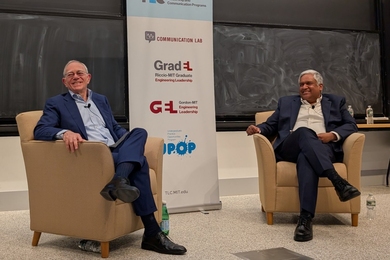Leon Glicksman designs buildings with an eye toward improved energy efficiency, and, like many of his MIT colleagues, he brings with him a high-tech portfolio. He develops aerogel panels to improve insulation and software packages to guide architects. The professor of architecture and mechanical engineering says that both will be needed in the retrofitting of existing buildings and the creation of new ones around the world.
But while these kind of applications are attractive, Glicksman adds that solutions don’t have to come out of a lab. Sometimes the answer is as basic as opening a window; the key is knowing when to do it. It’s that education of how to optimally run a system or prove the effectiveness of a different approach that ultimately underlies all of his work.
The problem of invisibility
Glicksman’s focus is on thermal insulation, specifically controlling heat flow — and its loss — through walls. Fixing the problem of suboptimal heat flow is a relatively easy and necessary solution: Glicksman says that China alone is building 10 million housing units a year; in 10 years, the country’s additional floor area will be equal to all European countries combined, and India is also undertaking ambitious home building projects. With such looming construction, addressing heating and cooling issues at the start of a project would be the most prudent and cost-effective course.
But such pro-activity isn’t always possible. The United States has 100 million housing units, but only 1 million new ones are built every year. The need becomes retrofitting existing stock. Some structures make it relatively simple to blow more insulation into a wall, Glicksman says, but others, such as masonry construction, don’t allow for that.
One option is to use aerogel. It’s not a new technology, but, in conjunction with MIT professor of materials science and engineering Lorna Gibson, Glicksman has developed a fire-resistant insulation panel. The nanosized holes capture air molecules, reducing heat transfer through the walls so that warm or cool air will remain in a space, thereby lowering the need for mechanical systems.
While the remedy seems straightforward, challenges remain. On the qualitative level, since insulation isn’t visible, it’s not particularly exciting, and people tend to like aesthetically exciting solutions, Glicksman says. On a quantitative level, aerogel is light and provides little strength. A structure needs to be sturdy enough to hold the panel together and then be filled with insulation. Glicksman has worked with a large chemical company on the project. The company didn’t like the economics and hasn’t proceeded, “but I think we made some strides as far as some of the things we need to overcome if you wanted to use aerogel for those purposes,” he says. “We were able to combine the thermal insulating properties of aerogel with the structural rigidity of a conventional wall panel.”
Glicksman adds that finding a functional panel remains something of an imperative. Along with new and existing construction, there’s a need for affordable insulation. In countries such as India and North Pakistan, some people can’t afford heating or cooling units. Not only are homes adversely affected by extreme temperatures, but schools have to shut down for months in the winter.
Panels would perform two functions. They would keep schools open and provide opportunity, and as people’s standard of living increases, they would already be invested in using the technology. “Just the application of an inexpensive kind of insulation system could change essentially the educational program in that particular part of the world,” Glicksman says.
In another possibility, a recent project in India supported by the MIT Tata Center is testing new roof designs that combine insulation and structure. Indications are that when used with natural nighttime ventilation and externally insulated walls, the interiors are 5-7 degrees Celsius cooler than the outside during the hottest part of the day, Glicksman says.
Capturing the wind
Technology is sometimes the needed remedy, but Glicksman says it’s not the only one. Take natural ventilation: As Glicksman explains, opening up a window is obvious and effective. The obstacle is that many buildings don’t allow for that. Glicksman is working with developers in Japan and China on new structures that would bring the outside in. Heating and air conditioning systems would remain, but Glicksman is using a combination of elements: bringing in fans that draw in nighttime air; closing windows during the day to capture that cool air; and installing concrete floors, which maintain a comfortable daytime temperature without the use of air conditioning. The reliance on mechanical systems could then decrease by at least half, as has happened in buildings in San Francisco and Boston, he says.
Another low-tech option Glicksman is using in a central Tokyo building is an open floor plan. Combining it with a central duct would create a chimney effect, allowing cool air to circulate and exhaust to be removed. This setup is a good alternative to cross-flow natural ventilation, particularly in places without enough wind to run through the lower floors, Glicksman says.
The challenge for these approaches is in the education. People dismiss them as not being effective, but often the root issue is that the system isn’t designed correctly, or, at an even more basic level, it’s not being operated correctly. In one instance, Glicksman says, the heating and cooling units in a building were unknowingly running simultaneously. The effect is two-fold: The building never operates at peak efficiency, and skepticism builds to any kind of change because true results haven’t been experienced, he says.
Starting off strong
As with most problems, there’s no cure-all to minimizing a building’s faults, Glicksman says. In an ideal world, integrated design is the closest solution in which windows, floors, appliances, lights, and heating and cooling systems are installed simultaneously at the beginning. It makes sense and would eliminate operational overlap, but the move requires more money upfront. The increase could be modest because of integration, but the outlay is often coming from a developer who isn’t paying the utility bills.
Again, it comes down to education and creating the requisite incentives. In the case of China and India, with its building projections, the hope is to appeal to the government that long-term efficiency correlates to more comfortable working environments and higher worker productivity. There’s also a more general appeal. “If people realize that passive means can produce comfortable conditions, they wouldn’t be so eager to turn to air conditioning year round,” Glicksman says. “Maybe we can start moving the pointer in the right direction.”
As part of that movement, Glicksman has developed software that would allow architects and designers to be able to see different performance scenarios when drafting plans as it relates to daylight levels, window placement, air flow, comfort, and energy savings. The technology wouldn’t determine the optimal design, but it would give suggestions.
Ultimately, it might lead to smarter construction decisions, and, after that, technology could monitor a building. Faults and points of loss could be recorded, pinpointed, and fixed. That solution might be something as small as adjusting a section’s air conditioning or ensuring that a vent is properly closed at night. As with aerogel insulation, it’s not necessarily exciting stuff, but it’s often the most productive. Says Glicksman: “Simple sometimes is good.”











